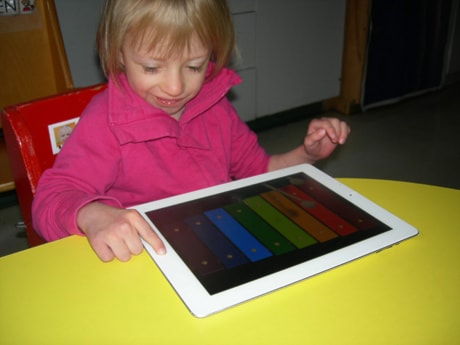TORONTO — Four-year-old Satu Kuisma smiles as she finds a picture of herself and touches it on the screen.
When teacher Sabrina Morey asks the kindergartner to tell her what she did in class that day, Satu taps away on the iPad, selecting pictures for eating, drawing and playing on swings.
Communication can be a struggle for Satu, who has a rare chromosome disorder.
Born at just 2 1/2 pounds, she has had developmental delays, one of the most prominent being her speech.
But she’s among dozens of non-verbal children at a Toronto school who are learning to communicate through touch technology.
Satu and the other students at the Beverley School are involved in a research project with University of Toronto professor Rhonda McEwen aimed at determining if devices like iPads make it easier for developmentally challenged children to communicate and interact with others.
So far, McEwen says, the answer is yes.
“These touch devices are in some ways bridging communications deficits that students who are non-verbal and who have some kind of developmental disorder have,” says McEwen.
Beverley is a school for students with a range of physical and mental challenges, including autism and deaf-blindness.
In November 2009, Morey brought her iPhone to class and kids who had been reluctant to communicate using picture cards “were immediately hooked,” she says.
Morey and fellow teacher Stacie Carroll developed a program where the pupils use an iPad or iPhone in 13 classrooms.
Their curriculum includes about 230 applications, such as Proloquo2Go, which features text-to-speech voices and almost 8,000 symbols, and iCommunicate.
McEwen collected data on 36 students, including detailed assessments on 12 for Phase 1 of her study last year. Phase 2 finishes in June.
She has found on average, a 20 per cent improvement in students’ ability to communicate using symbols.
Satu uses a few words, sign language and pictures to communicate.
Her mother Suvi Kuisma is pleased with her daughter’s progress and hopes she will use her iPod Touch at home and school to communicate any time she wants.
“We think some of the apps and videos she’s been watching have helped reinforce what she’s learning at school, like her recognition of the alphabet, numbers and colours as well as her vocabulary,” Kuisma says.
Autistic kids and children who have limited hearing or eyesight have also improved communications skills using the devices, says McEwen.
“They’d find a little game... and go up to another child and attempt to communicate and get joint attention which is one of the big areas that autistic children struggle with,” says McEwen.
Four-year-old Farhan Ahmod, who has autism, is just learning how to use the iPad. With help from Carroll, he points to the images for noodles and a drink box he wants for lunch.
“A lot of autistic children can’t read emotions,” says principal Alana Grossman. “They spend a lot of time trying to figure out what the teacher wants.”
But using the iPad, they don’t have to work with emotion, she said.
Farhan’s father Juber Ahmod said he’s seen a big improvement since his son started school and began using the iPad.
Farhan responds to his name and sits down and eats when asked, when before he didn’t understand.
Students like the device because it lets them work at their own pace and the iPad’s voice is not affected by mood or what else is happening in the room, said Carroll.
Satu appears to have mastered the technology. When Morey asks the little girl to find the letter S, she does it on cue and then chooses an image of strawberries as an example of something that starts with that letter.
“Perfect,” says Morey.
